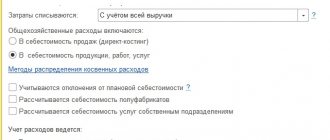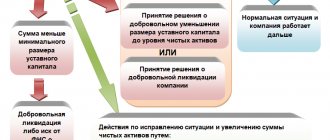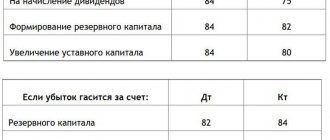The rules for accounting for securities are specified in the chart of accounts No. 94n. They must be accounted for in account 58. It is called “Financial Investments”. You can create subaccounts No. 1 and No. 2 for the account. Let's take a closer look at the rules for accounting for securities.
Question: How is the acquisition of shares traded on the organized securities market (OSM) reflected in accounting? The organization, under a purchase and sale agreement, acquired uncertificated shares at a price of RUB 1,000,000. The organization did not incur any other costs associated with the acquisition of shares. As of the last day of the month of acquisition of shares, their market value was RUB 1,020,000. For income tax purposes, income and expenses are determined using the accrual method. Interim financial statements are prepared at the end of each calendar month. View answer
What are securities?
Securities are documents confirming special property rights. Let's look at their types:
- Shares that give the right to receive part of the JSC's profits in the form of dividends.
- Bonds pay their face value as well as interest.
- A share gives the right to part of the company's property.
- A promissory note implies confirmation that one participant in the relationship must pay money to the other participant within a given period.
- Based on the check with the specified amount, the banking institution pays the funds to the other participant.
Typically, commercial firms purchase stocks and bonds.
How does a lender account for transactions under a securities lending agreement when taxing profits?
Features of securities valuation
Accounting for securities involves valuation. It can be carried out in various directions:
- Nominal cost. This is the price that is indicated on the paper itself. Considered a conditional value. That is, it does not reflect the actual cost of the paper.
- Market price. It is formed based on the values of supply and demand. The greater the demand, the higher the price. This type of cost gives an idea of the actual cost of the paper for a certain period.
- Book value. Represents the cost on the basis of which securities are recorded on the balance sheet.
- Accounting value. This is the value that is recorded in the accounting accounts.
- Liquidation value. It represents the cost of the liquidated joint-stock company, accrued per share.
If there is a difference between the nominal and market valuation, appropriate entries are made.
How to maintain tax accounting for securities denominated in foreign currency ?
Purpose of shares and actions performed with them
JSC issues this security. Their value at face value, circulation, and the amount of the authorized capital (AC) are determined by the first meeting of participants. These data are reflected in the Charter and documents for registration of the issue. The nominal price of the issued shares corresponds to the size of the authorized capital of the joint-stock company.
You can perform the following actions with shares: (click to expand)
- Issue additionally;
- Change the denomination;
- To be repurchased by the issuer;
- Cancel;
- Buy and sell, exchange, give;
- Invest in the management company.
Accounting rules for bills of exchange
Bills of exchange are recorded in account 58, subaccount 2. They belong to debt securities. The debit direction displays the arrival and multiplication of the number of bills, and the credit direction shows the disposal. Let's look at the entries used to keep records:
- DT58.2 KT62. Receiving paper.
- DT91.2 KT58.2. Write-off of paper costs.
- DT58.2. KT51. The company bought the bills from another party.
- DT58.2 KT62. The paper is sent for payment to another person.
- DT91.2 KT58.2. Write-off of the book value of the paper.
If bills of exchange are sold, this transaction is recorded in account 91. However, account 91 is relevant only if the sale of securities is not considered the basic activity of the company. If this is a basic activity, account 90 will be required. To record transactions involving securities, account 58 is used.
Question: What differences between accounting and tax accounting may arise if in accounting the value of retiring securities that are not traded on the organized securities market (OSM) is determined by the average initial cost, and for profit tax purposes - by the FIFO method? How are these differences reflected in accounting in accordance with the Accounting Regulations “Accounting for calculations of corporate income tax” PBU 18/02, approved by Order of the Ministry of Finance of Russia dated November 19, 2002 N 114n? View answer
Examples of transactions on account 96 in accounting
Let us study in more detail examples of transactions on account 96 “Reserves for future expenses”.
Example 1. Creating a reserve for vacation pay based on wages
To calculate the reserve, we use the formula: (OT + insurance premiums) / 28 * 2.33, where
- 28 – the number of vacation days per year for each employee, according to the collective agreement;
- 2.33 – number of vacation days for 1 month worked.
Hence:
- Insurance premiums - 30.2%;
- Salary in January - 250,000 rubles;
- January reserve: (250,000 + 75,500) / 28 * 2.33;
- Vesna LLC created a reserve for vacation pay in January in the amount of RUB 27,086.
Postings for creating a reserve in Vesna LLC for deferred holidays on account 96:
| Dt | CT | Transaction amount, rub. | Wiring Description | A document base |
| 20 | 96 | 27 086 | The amount of the reserve for paying vacation pay to employees is reflected | Accounting information |
Example 2. Creating a reserve for vacation pay based on average earnings
To calculate the reserve, we use the formula: (average daily earnings + insurance premiums) * vacation balance.
Reserve calculation:
- Average daily earnings: 2,750,000 / 29.3 / 12 = 7,821.39 rubles;
- Insurance premiums: 7,821.39 * 30.2% = 2,362.06 rubles;
- Reserve as of December 31, 2016: (7,821.39 + 2,362.06) * 30 = RUB 305,503.50.
Zima LLC has generated entries to create a reserve for vacations on account 96:
| Dt | CT | Transaction amount, rub. | Wiring Description | A document base |
| 20 | 96 | 305 503,50 | The amount of the reserve for paying vacation pay to employees is reflected | Accounting information |
Example 3. Creating a reserve for warranty repairs
- 12% of goods sold are subject to repair;
- 8% of goods sold are subject to replacement;
- The average cost of repairs per unit of goods is 650 rubles;
- The average cost of replacing a product is 4,500 rubles;
- During 2022, it is planned to produce 5,000 units of goods.
Thus:
- Calculation of the reserve amount for 2022: (5,000 * 12% * 650) + (5,000 * 8% * 4,500) = RUB 2,190,000.
- The amount of monthly charges to the reserve is equal to: 2,190,000 / 12 = 182,500 rubles.
Postings to account 96 to create a reserve:
| Dt | CT | Transaction amount, rub. | Wiring Description | A document base |
| 20 (23; 26; 44) | 96 | 182 500 | The amount of the reserve for warranty repairs is reflected | Accounting information |
Bond Accounting Rules
Accounting rules are approved in “Accounting for expenses on loans”. The debt to the bond owner is indicated as a loan obligation. For correspondence, accounts 66 and 67 are used. Which account should be used? This is determined by the type of debt on the bonds: short-term or long-term. For short-term debts, account 66 is used, and for long-term debts, account 67. Consider the types of accounting entries:
- DT76 KT51. Buying bonds.
- DT91.2 KT58.2. Debt identified.
- DT91 KT58.2. Amortization.
- DT58.2 KT91. Write-off of the difference between the initial and nominal valuation of securities.
- DT51 KT62. Receiving payments on papers.
If the funds paid are greater than the nominal value of the security, the amount of the difference is included in the structure of other income.
Basic postings with account 08
The table contains the main typical transactions with account 08 that every accountant encounters.
| Debit | Credit | The essence of wiring |
| 08 | 02 | We charged depreciation on equipment involved in the creation of a new non-current asset. |
| 08 | 05 | We calculated depreciation of intangible assets involved in the creation of a new asset. |
| 08 | 10 | The cost of materials used to create a non-current asset was written off. |
| 08 | 23 | The cost of auxiliary production services was written off to the cost of the asset. |
| 08 | 26 | We wrote off part of the general business expenses associated with the creation of the asset. |
| 08 | 60 | Purchased OS or intangible assets. |
| 08 | 66 / 67 | Interest on the loan was included in the value of the asset. |
| 08 | 70 | We paid wages to employees involved in the creation of the asset. |
| 08 | 69 | Insurance premiums were calculated from the salaries of employees involved in the creation of a non-current asset. |
| 08 | 75 | We received intangible assets as a contribution to the authorized capital. |
| 08 | 98 | Received a non-current asset free of charge. |
| 01 | 08 | The non-current asset was taken into account as fixed assets. |
| 03 | 08 | The non-current asset was taken into account as fixed assets for subsequent rental on a reimbursable basis. |
| 04 | 08 | The non-current asset was taken into account as an intangible asset. |
| 91 | 08 | The cost of a non-current asset sold or disposed of for another reason was written off. |
We recommend you the cloud service Kontur.Accounting. In our program, you will easily master the accounting of non-current assets and set up all the necessary analytics. You will also be able to keep records, calculate salaries, submit reports and use other accounting tools. We give all newbies a free trial period of 14 days.
Share Accounting Rules
To account for shares, accounts 58.1, 81 and 76 are needed. Accounting must solve the main task - control over the movement of shares of the company itself, as well as acquired shares. Postings are used to reflect the purchase, disposal, and sale of securities. Shares are the primary property of an enterprise that is included in the authorized capital. For this reason, the account 80 often appears in postings.
Let's look at the accounting entries used to account for shares:
- DT58.1 KT76. Purchase of shares.
- DT76 KT91. Calculation of interest on securities.
- DT91 KT58. Write-off of the value of securities disposed of due to sale.
- DT59 KT91. Write-off of the reserve formed due to depreciation.
- DT58 KT60. Accounting for the acceptance of securities on the balance sheet.
If a company has purchased shares, it must send a corresponding notification to the tax office. Also, the fact of purchase is recorded in the documentation. The purchase of shares must be reflected in the quarterly report. However, an accountant may also record relevant information in documents at the time of purchase. For example, this could be the preparation of sales and purchase agreements.
Example and entries for account 28 for accounting for defects in production
Let us consider in more detail an example of recording transactions on account 28 “Defects in production”.
Let’s say that at an industrial enterprise in April 2016, an inspector discovered 2 defective products. In the document Act on Internal Defects, the controller indicated that defective products in the amount of 1 piece are classified as correctable defects, and defective products in the amount of 1 piece are classified as irreparable defects. Wherein:
- The cost of materials is 800 rubles;
- The salary of the employee who corrected the defect is 3,500 rubles;
- Insurance contributions from an employee’s salary are 1,260 rubles;
- 3,500 rubles are withheld from the salary of the employee who committed the marriage;
- General production expenses amounted to 150 rubles;
- Returnable waste after writing off defective products amounted to 300 rubles.
The accounting reflects the following accounting entries for account 28 “Defects in production”:
| Dt accounts | CT account | Transaction amount, rub. | Wiring Description | A document base |
| A fixable marriage | ||||
| 28 | 10 | 800 | The material costs of correcting the defect are reflected | Limit fence cards |
| 28 | 70 | 3 500 | The salary of the employee who corrected the defect is reflected | Help-calculation |
| 28 | 69 | 1 26 | Insurance premiums of the employee who corrected the defect are reflected | |
| 73 | 28 | 3 500 | Reflects the amount withheld from the salary of an employee who committed a marriage | |
| 20 | 28 | 2 060 | Expenses for correcting defects are written off to the cost of production (800.00 + 1,260.00) | |
| An irreparable marriage | ||||
| 28 | 20 | 5 710 | The cost of defective products was written off (3,500.00 + 800.00 + 1,260.00 + 150.00) | Internal Marriage Act |
| 73 | 28 | 3 500 | Reflects the amount withheld from the salary of an employee who committed a marriage | Help-calculation |
| 10 | 28 | 300 | Returnable waste from defective products is entered into the warehouse | |
| 20 | 28 | 1 910 | Losses from defects are written off to the cost of production (5,710.00 – 3,500.00 – 300.00) |
Example of bond accounting
The company bought bonds of a banking institution in the amount of 1,500 rubles. The par value of the securities was 1,000 rubles. In this case, an expense occurs in the form of payment to the issuer. The maximum maturity period is 2 years. The owner of the bonds receives an income of 40% per annum every 6 months. In this case, the following transactions are performed:
- DT76 KT51. The cost of bonds in the amount of 1,500 rubles was transferred to the issuer.
- DT58.1 KT76. Fixation of the book value of securities in the amount of 1,500 rubles.
- DT76 KT91. Accrual of dividends in the amount of 300 rubles.
- DT51 KT76. Transfer of dividends in the amount of 300 rubles.
- DT91 KT58. Fixation of the share of reduction in the value of bonds.
This example lists the minimum number of transactions. However, in practice, as a rule, the number of transactions can reach 20.
IMPORTANT! In accounting, securities are recorded at their book value.
The bond issuer will use these shares:
- DT51 KT67. Issue and sale of securities at par value, if the par value is less than the purchase price.
- DT51 KT67. Issue and sale of securities at purchase price, if the nominal value is greater than the purchase price.
- DT51 KT98. The positive difference between the purchase price and the nominal value is taken into account. It is recognized as income in subsequent periods.
- DT97 KT67. A negative difference has been created.
- DT26 KT67. Interest accrued.
The write-off of differences between the nominal and purchase prices is recorded using these entries: DT98 KT91 and DT91 KT97.
Which accounts does 81 accounts correspond to?
Important! When a company buys back shares owned by a shareholder from a shareholder, an entry is made in the debit of account 81 for the amount of expenses incurred. When canceling its own shares purchased by the company, accounting is carried out in the credit of account 81 and the debit of account 80 after the company has completed all the prescribed procedures. If there is a difference in 81 accounts between the costs incurred for the purchase of a share or share and their nominal value, it is allocated to 91 accounts.
81 accounts correspond with the following accounts:
| By debit | By loan |
| Account 50 "Cashier" Account 51 “Current accounts” Account 52 “Currency accounts” Account 55 “Special accounts” Account 91 “Other income and expenses” | Account 73 “Settlements with personnel for other operations” Account 80 “Authorized capital” Account 91 “Other income and expenses” |
Errors that often occur when accounting for securities
Errors in accounting can be significant or insignificant. The former can influence the decisions of managers and raise questions among regulatory authorities. Therefore, the occurrence of major errors is unacceptable. Let's look at common accounting errors that are significant:
- Entering incorrect entries. For example, this could be the use of incorrect accounts or incorrect transaction amounts.
- Incorrect accounting of the buyer's bill. The security must be recorded in account 58. However, if the buyer has issued a bill of exchange, it must be recorded in the debit of account 62. If the person has transferred the security to third parties, the security is classified as short-term debt.
- When a company receives a bill of exchange free of charge, it does not notify the tax office about it. This is also a significant mistake, since reports must also be sent to the Federal Tax Service on gratuitous receipts.
- Expenses arising from the sale of securities are recorded as expenses. However, this is incorrect, since sales expenses cannot reduce tax payments.
A significant mistake is also the lack of primary documentation. Postings are always based on documents.
What is 81 accounts for?
81 accounts are used to summarize information about the availability and movement of the company’s own shares. Shares are purchased from shareholders, after which further transactions are carried out with them. Actions with shares will depend primarily on the decision of the owner, that is, the buyer. When repurchasing shares, an entry is made in the accounting debit of account 81 for the amount of money actually spent. When canceling securities, correspondence is carried out with the authorized capital. The difference that appears from 81 accounts is allocated to 91 accounts
Important! In agricultural structures, repurchase can be carried out for the amount of actual costs, both on the debit and credit of the accounts used when accounting for money.
Documents required for transactions
Shares are acquired under a purchase and sale agreement. It must be in writing and must contain the following information:
- Details of the parties;
- Information about the object of the transaction: issuer, details, par value, etc.;
- Cost of securities upon purchase;
- Other conditions: payment terms, fines, etc.
The purchase of shares is formalized by a randomly drawn up primary document. For example, an act of acceptance and transfer. The acquisition is also confirmed by extracts from the acquirer’s account or from the register.
Payment for shares is reflected in bank statements and payment documents. When securities are stored at the cash desk, they are recorded in a special register (book). The document contains basic information about the shares and is kept in two copies.





